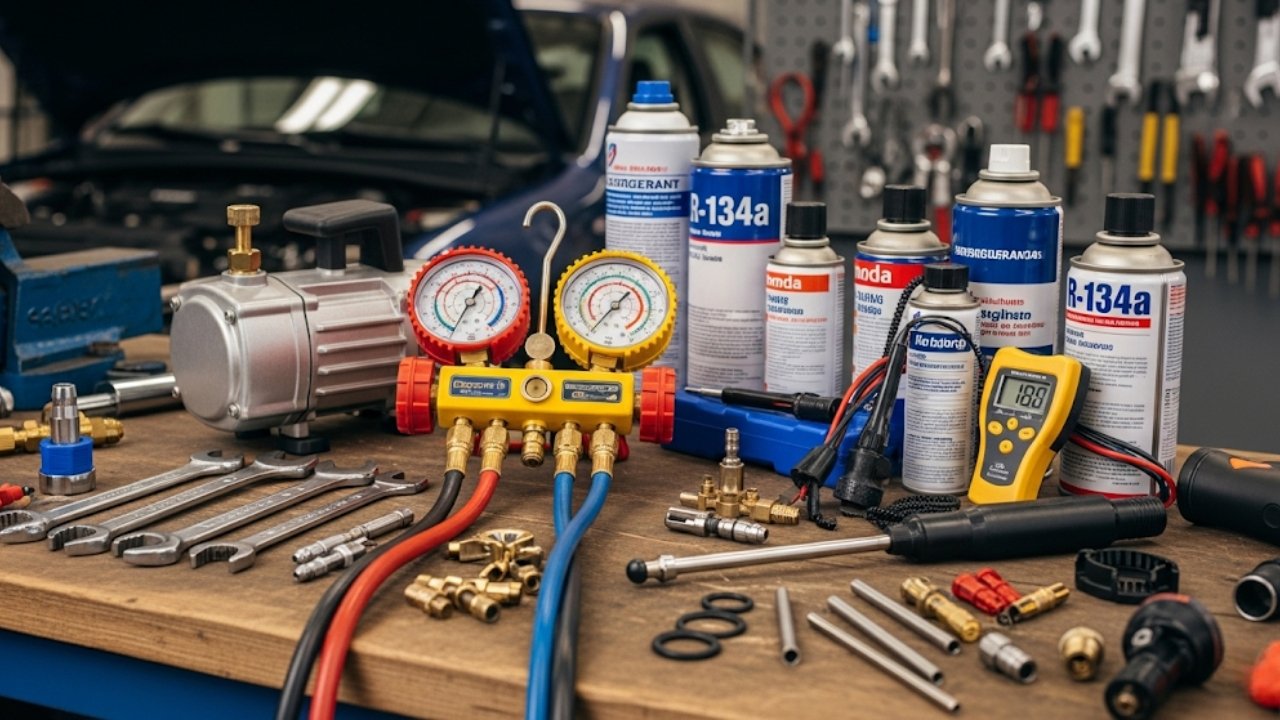Car Air Conditioning Tools & Equipment

Introduction: The First Time I Felt Real Relief Behind the Wheel
I still remember the first time my car’s AC system saved the day. It was a scorching summer afternoon, I had the windows down for hours, but the heat was unbearable. Then I hit the A/C button, and that wave of cold air? Pure magic. That simple breeze turned my suffering into comfort. It made me wonder—what hidden tools made that bliss possible? Over the years, I dug deep into the world of car air conditioning tools & equipment, tested a bunch myself, and found some gems I now swear by.
So today, I’m pulling back the curtain and sharing what really makes your car’s air conditioning tick—from essential toolkits to pro-level gadgets. Whether you’re a DIY car lover or just curious, this guide will walk you through everything you need to know.
Why Every Car Owner Should Care About AC Tools

Here’s why they matter:
-
️ DIY Repairs Are Cheaper: A mechanic visit can cost hundreds, but with the right tools, you can handle small issues yourself.
-
️ Better Performance: Regular maintenance with proper equipment ensures your A/C blows strong and cold.
-
Early Problem Detection: Tools like leak detectors help you catch issues before they snowball into expensive repairs.
-
Peace of Mind on Long Drives: You don’t want your AC failing in the middle of nowhere. Having tools on hand can make a huge difference.
Let’s explore these tools one by one—and why they deserve a spot in your garage or trunk.
Top 5 Must-Have Car Air Conditioning Tools & Equipment
1. Valve Core Quick Remover Tool Kit
Imagine trying to change a valve core without losing refrigerant. Messy, right? That’s where tools like the WADEO R134A Valve Core Quick Remover Installer come in. It’s like having a magic wand for your A/C system.
Key Benefits:
-
No Refrigerant Loss: Remove and replace cores without evacuating the entire system.
-
High/Low Pressure Compatibility: Fits both sides of the system.
-
Anti-Slip Design: Perfect for slippery fingers on hot days.
This tool saved me more than once when dealing with stubborn or leaking valve cores. It works with R134A refrigerant systems, the standard in most vehicles today.
2. Refrigerant Recharge Hose with Pressure Gauge
Next up is the YSTOOL AC U Charge Hose with Gauge. If your A/C is blowing warm air, chances are it’s low on refrigerant. This tool lets you recharge your system safely and accurately.
What Makes It Stand Out:
-
Large Dial Gauge: Easy to read, even in direct sunlight.
-
Quick Coupler Tap: Fast connect/disconnect with no gas leaks.
-
Anti-Corrosion Brass Build: Long-lasting and durable.
Even if you’re not a pro, this tool makes recharging intuitive. Just follow the instructions and you’re back to cool air in minutes.
3. Universal Valve Core and Seal Cap Kit (102 PCS Set)
This one’s a lifesaver—the OCR 102PCS Kit includes everything from valve cores to dual-head remover tools. I keep it in my trunk at all times.
What’s Inside:
| Component | Quantity | Use |
|---|---|---|
| R12 Valve Cores | 30 | Older vehicles |
| R134A Valve Cores | 30 | Most modern cars |
| Seal Caps | 30 | Prevent leakage |
| Dual-Head Remover Tool | 2 | Easy core removal/install |
This kit is perfect for emergencies or workshops, especially if you deal with multiple vehicles. Organized in a clear box, it saves time digging around in your toolbox.
Understanding the Core Function of AC Tools
To maintain your vehicle’s air conditioning system, it helps to understand what each tool actually does. Here’s a breakdown in simple terms:
-
Valve Core Removers: These are used to take out or replace the internal part of a valve where refrigerant flows.
-
Charging Hoses with Gauges: Used to refill refrigerant and monitor system pressure during charging.
-
Leak Detectors: These electronic or UV-based tools sniff out leaks invisible to the naked eye.
-
Vacuum Pumps: Remove air and moisture before recharging refrigerant—essential for long-term performance.
-
Manifold Gauge Sets: These read high and low pressure to help diagnose compressor or line problems.
All these tools work together to ensure your car’s A/C system runs like new.
How I Chose and Tested My Tools
I didn’t just pick tools based on reviews—I put them to work. I tried each on my personal car, and on a couple of friends’ vehicles that had AC issues. Here’s how I evaluated them:
-
Ease of Use: Could a first-timer figure it out?
-
Durability: Was it built to last?
-
Performance: Did it do what it promised?
-
Value for Money: Was it worth the price?
In every test, the WADEO, YSTOOL, and OCR tools stood out. They combined performance with affordability and were intuitive even for someone new to car maintenance.
Buying Guide: How to Pick the Right Tools for Your Car
Choosing the right car air conditioning tools & equipment isn’t just about grabbing the most expensive set. Here’s what to keep in mind:
1. Know Your AC System
Is your car using R12 or R134A refrigerant? Newer cars use R134A. Make sure your tools match your system type.
2. Start with Essentials
Begin with these 4:
-
Charging hose with gauge
-
Valve core remover
-
Leak detector
-
Vacuum pump
3. Look for Quality Materials
Aluminum alloy, stainless steel, and brass are great indicators of durability.
4. Think About Portability
Do you travel often? Go for a compact kit that’s easy to carry.
5. Stay Within Budget
High-quality tools don’t have to break the bank. The sets I’ve reviewed offer solid performance at reasonable prices.
Safety Tips for Using AC Tools
While working with AC systems, safety always comes first. Here are some tips I live by:
-
Wear Safety Goggles: Refrigerant can freeze skin or cause eye injuries.
-
Work in a Ventilated Area: Especially when using chemicals or vacuum pumps.
-
Follow Instructions: Don’t guess—use the manual.
-
Check for Leaks Before Charging: Avoid wasting refrigerant or damaging your system.
-
Store Tools Properly: Keep them in a dry, safe place to extend lifespan.
Advanced Car AC Tools for Professionals & Enthusiasts
If you’re beyond basic maintenance and ready to handle full-scale AC jobs, consider adding these pro-level car air conditioning tools & equipment to your arsenal:
1. Manifold Gauge Set
This tool is the heartbeat monitor of your AC system. It reads both high and low pressure lines, giving a full picture of refrigerant flow.
Why It’s Worth It:
-
Helps diagnose issues like compressor failure or clogged expansion valves.
-
Comes with color-coded dials for intuitive reading.
-
Supports vacuum and refrigerant charging in one setup.
Pro Tip: Always match your gauge set to your vehicle’s refrigerant type (R134A, R1234yf, etc.). Some kits include adapters for compatibility.
2. Refrigerant Leak Detector
Leaks can be sneaky. Sometimes, your refrigerant just disappears—without a trace. That’s where a leak detector shines.
What It Does:
-
Detects minute refrigerant leaks via sensors or UV dye.
-
Alerts you via beeps or lights when a leak is present.
-
Some models even show you the severity of the leak.
I recommend investing in an electronic leak detector with sensitivity levels as low as 0.1 oz/year for precise detection.
3. Vacuum Pump
Before you recharge your AC system, you must evacuate it. That’s where a vacuum pump comes in.
Why You Need It:
-
Removes moisture and air from the system.
-
Prevents internal corrosion and system inefficiency.
-
Ensures refrigerant isn’t diluted or compromised.
A two-stage rotary vacuum pump is usually best for home and light commercial use.
My Routine: How I Maintain My Car’s AC Using These Tools
Over time, I developed a routine to keep my car’s AC system running like a dream. Here’s my simplified process:
Step-by-Step AC Maintenance
-
Visual Check
Inspect hoses, belts, and compressor connections for cracks or leaks. -
Pressure Test
Hook up my manifold gauge set to check for pressure abnormalities. This tells me if refrigerant is low. -
Leak Detection
If pressure is low, I use my UV leak detector. It’s like a detective light—what’s hidden becomes obvious. -
Evacuate the System
Connect the vacuum pump for about 30-45 minutes to pull out moisture and air. -
Recharge Refrigerant
Using the charging hose with gauge, I refill the system to the proper pressure. -
Final Check
Run the AC and check vent temperature, listen for unusual noises, and confirm system is cycling correctly.
This process takes about 1-2 hours and can save me $200–$500 in shop charges.
Quick Checklist: What You’ll Need
Here’s a bullet-point recap of the essential tools we’ve covered:
Valve Core Remover Tool
Refrigerant Charging Hose with Gauge
Manifold Gauge Set
Refrigerant Leak Detector
Vacuum Pump
Seal Cap & Valve Core Kit (102 PCS)
Optional (but helpful):
Refrigerant Scale
UV Dye Kit
Quick Couplers for Faster Connections
Keep them organized in a sturdy toolbox, and label everything. Trust me, it saves time.
Top Brands to Consider
Here’s a comparison of some of the brands I’ve personally tested:
| Brand | Notable Product | Pros | Rating |
|---|---|---|---|
| WADEO | Valve Core Remover Kit | Strong build, anti-slip design | ⭐⭐⭐⭐⭐ |
| YSTOOL | AC U Charge Hose | Easy gauge reading, great for beginners | ⭐⭐⭐⭐⭐ |
| TWTADE | Core Installer Set | Compact and efficient | ⭐⭐⭐⭐⭐ |
| OCR | 102PCS Kit | Complete set, great value | ⭐⭐⭐⭐⭐ |
| gohantee | Dual Head Valve Remover | Affordable and durable | ⭐⭐⭐⭐⭐ |
Each of these has earned their spot for quality, value, and ease of use.
FAQs About Car Air Conditioning Tools & Equipment
1. Can I recharge my car’s AC system by myself?
Yes, if you have the right tools. With a recharge hose, gauge, and refrigerant, it’s doable—but always follow safety protocols.
2. Is it safe to use AC tools without experience?
For basic maintenance—yes. Tools like charging hoses or valve core removers are user-friendly. For deeper diagnostics, it’s best to watch tutorials or consult a pro.
3. How often should I check my car’s AC system?
Once a year before summer hits is ideal. Regular inspections can prevent costly repairs.
4. What refrigerant type does my car use?
Most vehicles post-1995 use R134A. Newer models may use R1234yf. Check your vehicle manual or under-hood label.
5. Why is my AC blowing hot air even after recharging?
It could be a leak, bad compressor, or clogged components. Use tools like manifold gauges and leak detectors to pinpoint the problem.
6. Do these tools work for trucks or SUVs?
Yes. Most car air conditioning tools & equipment are compatible with larger vehicles, as long as the refrigerant type matches.
7. What should I avoid when using AC tools?
Avoid overcharging, using the wrong refrigerant, or skipping leak detection before recharge. Always wear safety gear.
8. Can I use household AC tools on my car’s system?
No. Car systems use different pressures and refrigerants. Use tools specifically designed for automotive systems.
Final Thoughts: Why It’s Worth Investing in the Right Tools
Your car’s AC system isn’t just about comfort—it’s about safety, air quality, and long-term vehicle health. Having the right car air conditioning tools & equipment empowers you to take charge of basic repairs, save money, and stay cool when it counts most.
Whether you’re a weekend DIYer or someone who just wants to beat the heat, investing in a solid toolkit is one of the smartest moves you can make for your vehicle.
So next time you feel that first blast of icy air on a hot day, remember—behind that comfort is a well-maintained system and the tools that made it possible.





